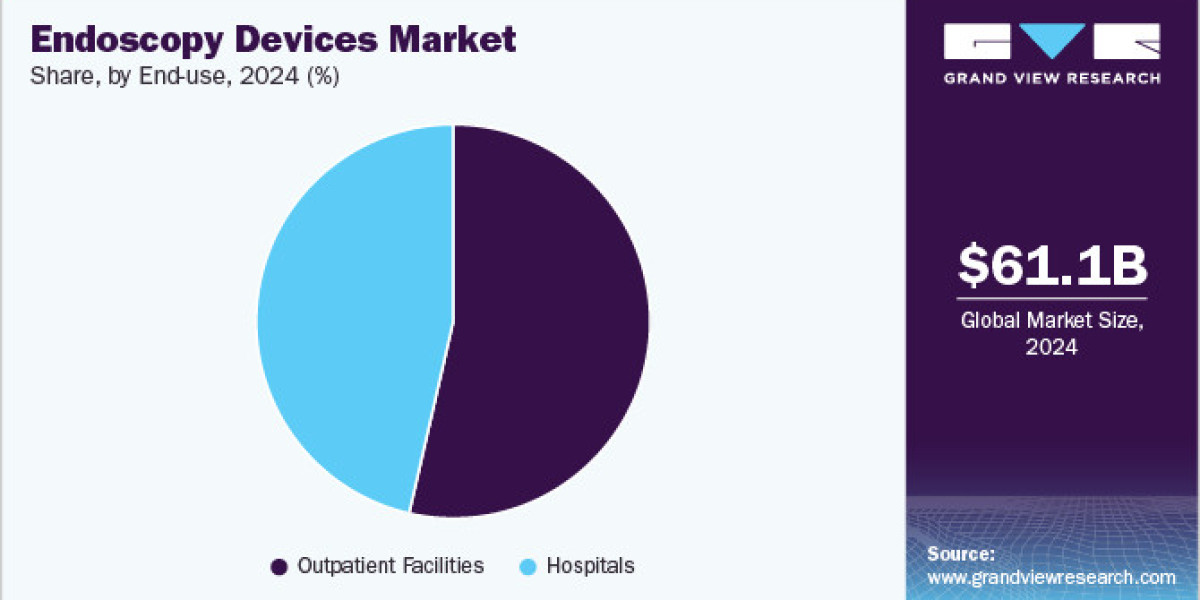The global endoscopy devices market size was estimated at USD 61.06 billion in 2024 and is expected to grow at a CAGR of 3.79% from 2025 to 2030. The less invasive properties and affordable post and pre-procedure cost of endoscopy devices are the major factors anticipated to boost the market growth over the forecast period. Furthermore, a shift in trend to use disposable endoscopic components to minimize the procedure cost as well as the chance of cross-contamination is also expected to accelerate market growth over the years.
In addition, the growing chronic disease burden and increasing geriatric population all over the globe are also anticipated to fuel the adoption of advanced endoscopic devices such as wireless capsule endoscopy and high-definition camera & camera systems during the coming years. Moreover, growing medical conditions due to the increasing geriatric population often require endoscopic intervention such as liver abscess, gall stones, endometriosis, and intestinal perforation, which in turn anticipated to drive the market for endoscopy devices over the forecast years. For instance, as per the Administration on Aging (AoA) of the U.S. Department of Health and Human Services report, about 16% of the population were aged above 65 years during 2019. This number is expected to increase to 21.6% by 2040.
Gather more insights about the market drivers, restrains and growth of the Global Endoscopy Devices Market
In addition, increasing preference by medical professionals to use technologically advanced endoscopy devices equipped with a high-definition camera and light sources to help physicians analyze internal organs of interest also drives the market. For example, Stryker, Olympus Corporation, Fujifilm Holdings Corporation are some of the key pioneers in high-definition camera systems. The shift of preference towards minimally invasive surgical procedures than traditional surgeries to reduce hospital stay and minimize post-procedure complications are the major factors anticipated to fuel the demand for endoscopy devices. Hence, factors such as higher patient satisfaction, increased economic viability, and lesser hospital stay are expected to increase the demand for minimally invasive endoscopic interventions in the coming years, thereby accelerating market growth.
Product Insights
The product segment comprises of endoscopes, endoscopy visualization systems, endoscopy visualization components, and operative devices. The endoscopes segment dominated the market in 2024 and accounted for the largest revenue share of 41.1% and is also anticipated to register the fastest growth rate over the forecast period. Growing awareness and rising adoption rate of endoscopes across various diagnostic and therapeutic procedures is driving the market growth of endoscopes. In addition, endoscopes aid in diagnosis of complex disease conditions such as cancer, GI disorders, urinary disorders, and lung disorders.
End Use Insights
The outpatient facilities’ segment dominated the market in 2024 and accounted for the largest revenue share of 53.6%. The outpatient facilities are also anticipated to register the fastest growth over the forecast period. Outpatient facilities such as ambulatory surgery centers and diagnostic clinics are expected to witness lucrative growth owing to growing preference for minimally invasive procedures to lower overall cost and reduce the number of days of hospital stays are some of the major factors expected to drive the growth of the segment. In addition, faster recovery time, and minimal discomfort due to the use of less invasive keyhole endoscopic procedures also accelerates the adoption of endoscopy devices in outpatient facilities, which in turn is anticipated to propel segment growth over the forecast period.
Browse through Grand View Research's Healthcare Industry Research Reports.
· Dried Blood Spot Collection Cards Market: The global dried blood spot collection cards market size was valued at USD 399.49 million in 2024 and is projected to grow at a CAGR of 4.73% from 2025 to 2030.
· Veterinary Dental Equipment Market: The global veterinary dental equipment market size was valued at USD 470.5 million in 2023 and is projected to grow at a CAGR of 7.2% from 2024 to 2030.
Regional Insights
The North America endoscopy devices market dominated the market and accounted for the largest revenue share of 39.8% in 2024. The high prevalence of several diseases, such as Gastrointestinal (GI) disorders, respiratory conditions, urological problems, gynecological issues, and cancer, is increasing the need for endoscopic procedures for diagnosis & treatment in North America. For instance, according to a report by ResearchGate, it is projected that there will be 2.0 million new cases of cancer and 611,720 cancer-related deaths in the U.S. in 2024. Hence, the growing need for accurate and minimally invasive diagnostic tools is driving the adoption of endoscopes and endoscopy devices.
Key Endoscopy Devices Company Insights
Key participants in the endoscopy devices market are focusing on devising innovative business growth strategies in the form of product portfolio expansions, partnerships & collaborations, mergers & acquisitions, and business footprint expansions.
Key Endoscopy Devices Companies:
The following are the leading companies in the endoscopy devices market. These companies collectively hold the largest market share and dictate industry trends.
· Olympus Corporation
· Boston Scientific Corporation
· PENTAX Medical (Hoya Corporation)
· FUJIFILM Holdings Corporation
· Karl Storz GmbH & Co., KG
· Stryker
· Medtronic
· Ambu A/S
Order a free sample PDF of the Endoscopy Devices Market Intelligence Study, published by Grand View Research.







